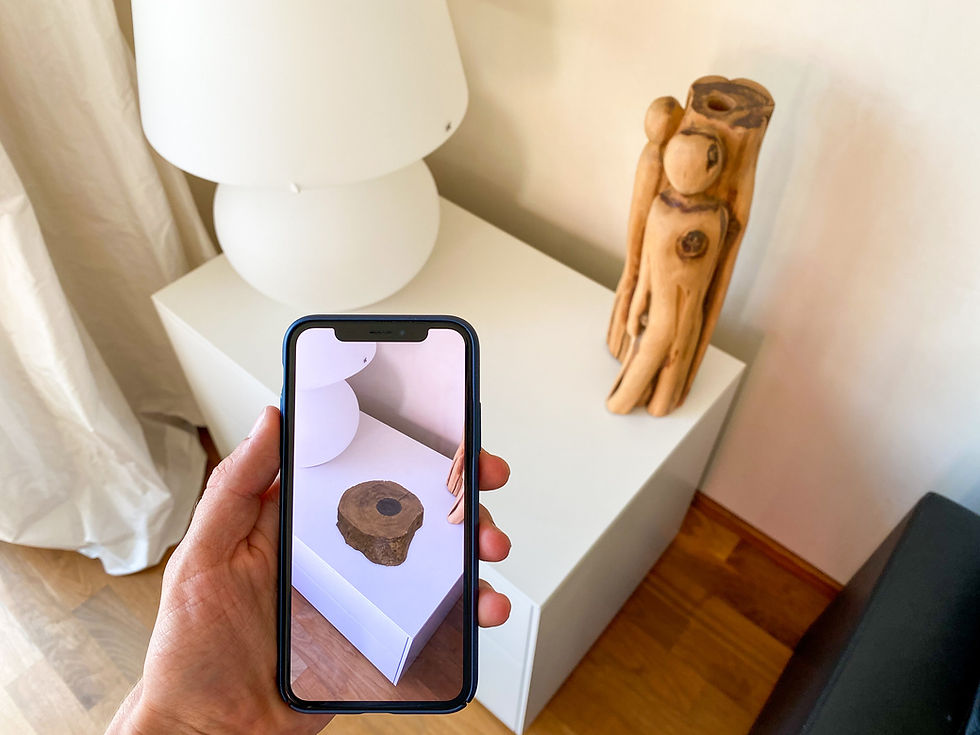The Future of User Interface | Virtual and Augmented Reality
- Nileesha Dilshan
- Mar 6, 2023
- 4 min read
Updated: Mar 9, 2023
We've been thinking about AR and VR as the future for decades, but it appears that they're finally the next breakthroughs in UX and UI design. AR and VR have first appeared to be gimmicks, but many designers anticipate they will evolve rapidly over the next five years and become much more popular. This will need the development of appropriate user experiences and virtual and augmented reality interfaces.
VR or known as Virtual Reality involves creating a virtual environment with which users can interact via specialized head-mounted displays and hand controllers. AR also refers to Augmented Reality, on the other hand, includes superimposing digital content onto the actual environment via devices such as smartphones or head-mounted displays.

Table of Contents
Virtual Reality
Virtual Reality is a technology that allows users to immerse themselves in a specially designed/simulated world for a specific purpose like medical training, games, and so on, which are explored in 360 degrees without limitations and boundaries. VR produces a virtual, simulated environment in which individuals interact via VR goggles or other devices.
Virtual reality technology can manipulate the brain into believing that a virtual world is realistic by simulating the sensations. This results in a more immersive experience. This is accomplished through the use of specific hardware components, such as;
Head-Mounted Displays (HMDs)
Spatial Audio Headphones
Motion Tracking Sensors
Controllers
Types of Virtual Reality
Non-Immersive Virtual Reality
Fully Immersive Virtual Reality
Semi-Immersive Virtual Reality
Collaborative Virtual Reality
Applications of Virtual Reality
In Education
When applied in education, virtual reality enables immersive learning environments in which students could study a wide range of subjects and concepts Virtual reality, for example, may be used to reproduce historical events, scientific theories, and much more. Using VR in education helps apply theories in a more practical way.
For Training
In terms of Defense, VR helps soldiers can train the experience of battlefield environments in real-time to avoid unconditional situations in reality.
VR facilitates medical professionals to analyze and research by avoiding direct interaction with dangerous chemicals and risk factors. Surgeons can use it to practice operations without risks.
For Entertainment
Virtual reality is frequently used in the gaming industry, where users can become immersed in a virtual world and interact with various elements and characters. It can also be used for cinematic experiences, allowing users to immerse themselves and participate in new ways.

Augmented Reality
Augmented reality (AR) is a technologically enhanced representation of the real physical world that is created by the use of digital visual components, sound, or other sensory stimulation. Unlike virtual reality (VR), which generates a completely created environment, users of augmented reality (AR) encounter a real-world environment with produced perceptual information superimposed on top of it.
Augmented reality can be accessed in a variety of methods, including smartphones, tablets, and glasses. AR is also being explored for use in contact lenses. Hardware components such as a CPU, sensors, a display, and input devices are required for the technology. Sensors such as cameras, accelerometers, Global Positioning Systems (GPS), and solid-state compasses are already used in mobile devices. This makes augmented reality more accessible to the average user. A GPS is used to locate the user's position, and its compass, for example, is used to determine device orientation.
Types of Augmented Reality
Marker-Based Augmented Reality
Markerless Augmented Reality
Projection-Based AR
Location-Based AR
Overlay AR
Contour-Based AR
Applications of Augmented Reality
It can be applied to a wide range of applications, including
Interactive demos
3D product graphics
Translations
Education
Facial recognition
Autonomous processes
Marketing


Common Benefits of VR and AR
Enhanced Interaction and Immersion
The capability to create realistic experiences that allow users to engage with digital material in a more natural way is what VR and AR in UI design are all about. To interact with content, traditional interfaces such as desktops or mobile devices rely on a series of clicks or swipes. But compared to that, VR and AR enable consumers to engage with digital content in a more intuitive and natural way. Users can, for example, literally walk around a virtual world, grip and move items with their hands, and even communicate with virtual assistants. It has the possibility of making tasks like product presentations, training sessions, and even entertainment more engaging and memorable.
Improved Accessibility
Regular interfaces can be troublesome for disabled users, such as those with vision or movement impairments. Yet, virtual reality and augmented reality (AR) can provide new methods for these individuals to interact with digital content.
Users with vision impairments, for example, might traverse a virtual world using audio signals or haptic feedback, whereas users with motor impairments can engage with virtual material using hand controllers or even eye tracking.
Will have a new market for Innovations
Designers can develop interfaces that integrate with the user's real-world environment, such as an augmented reality app that overlays digital material over a physical product. They can also design interfaces that make use of the user's physical movements, such as a VR game that requires the user to physically move to play.
VR and AR, in addition to new interface designs, provide new options for data visualization and analysis. A VR interface, for example, could show complicated data sets in an easy-to-understand and interact-with format, allowing users to get insights that would be impossible to obtain via traditional interfaces.
AR vs VR
Augmented Reality | Virtual Reality |
Uses a real-world setting | Uses an entirely virtual environment |
Users have control over their physical presence in the environment | Users are controlled by the system |
AR can be accessed via a single smartphone | VR requires a headset device |
AR improves both the virtual and real worlds | VR simply improves a fictional reality |
Requires higher Bandwidth | Requires relatively low Bandwidth |
Overall, virtual reality and augmented reality provide exciting new opportunities for UI design, with the potential for improved immersion, interaction, and accessibility. Designers, on the other hand, must address new design problems that are associated with these technologies. We should expect to see increasingly more creative and successful UI designs integrating VR and AR as technology evolves and becomes more accessible.






Comments